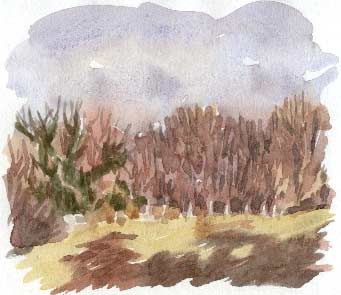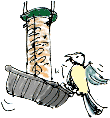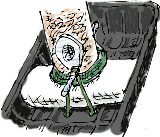 I’VE
BEEN concentrating on line drawing this week and, when I have used colour,
I’ve kept to the selection of primaries in my pocket-sized watercolour
box. On this grey afternoon, as the light fades (even though it’s only
just gone half past three), I spend 15 to 20 minutes working mainly with earth
colours and muted versions of the primaries from my larger White Nights
watercolours box:
I’VE
BEEN concentrating on line drawing this week and, when I have used colour,
I’ve kept to the selection of primaries in my pocket-sized watercolour
box. On this grey afternoon, as the light fades (even though it’s only
just gone half past three), I spend 15 to 20 minutes working mainly with earth
colours and muted versions of the primaries from my larger White Nights
watercolours box:
Sepia, raw sienna, yellow ochre, English red, olive green, cobalt blue,
cerulean blue, Payne’s grey and the odd touch of madder lake light (crimson).
I
like to be in control, so it’s rather unusual for me to go so much
for the watercolourist’s technique of letting the colours run together,
but this afternoon that’s what the sky, wood and meadow look like.
Dry Brush
When
the background is sufficiently dry I add detail to the wood and meadow with
my usual dry brush technique, losing some of the spontaneity but, there you
are, that’s
the way I see
things, even when I'm looking through a rain-spattered window. In watercolours
'dry brush' doesn't mean entirely dry; it indicates the opposite of sloshing
on the paint. It's the technique I use most in wildlife illustration - so controlled!
I made no pencil outlines, I just started with the sky and worked downwards.
It's not a precise subject that needs an initial drawing; there isn't much
structure in that mass of winter branches.
The fence posts gave me a chance
to include something with more definition; I painted the brown spaces and
left the paper showing through
to
indicate
the posts.
I gave them a very pale wash of grey when the brown had dried.
Pared-down Palette
After the line drawing I've done this week along with using my pared-down
palette of primaries, the indulgence of going for the broader range of colours
is like
going from
a string quartet
to a brass band. Which do I like best? It depends on the mood I’m in.
Looking at the sketch again, there appears to be a strong shadow in the foreground,
as if low winter sun is shining on the wood. In fact the brown patches are
mud where the resident ponies have trampled the lower end of the field.

 The
Swinging Spill-tray
The
Swinging Spill-tray
Willow,
blue, coal, long-tailed and great
tits come to the feeders along with siskin,
goldfinch and robin but I’m afraid
my new spill tray isn’t
too popular. Whenever a bird lands on it, the tray swings abruptly to one side,
scaring most of the birds away.
To prevent it swinging freely I needed something I could wedge in between
the feeder and the recycled plastic tray. Looking in the back of the garage
for an offcut of wood, I discovered something that works perfectly; in
the recycling bin there was a plastic shampoo bottle which, with the top sliced
off was just the right shape and depth to wedge in firmly.
 I’VE
BEEN concentrating on line drawing this week and, when I have used colour,
I’ve kept to the selection of primaries in my pocket-sized watercolour
box. On this grey afternoon, as the light fades (even though it’s only
just gone half past three), I spend 15 to 20 minutes working mainly with earth
colours and muted versions of the primaries from my larger White Nights
watercolours box:
I’VE
BEEN concentrating on line drawing this week and, when I have used colour,
I’ve kept to the selection of primaries in my pocket-sized watercolour
box. On this grey afternoon, as the light fades (even though it’s only
just gone half past three), I spend 15 to 20 minutes working mainly with earth
colours and muted versions of the primaries from my larger White Nights
watercolours box:
 The
Swinging Spill-tray
The
Swinging Spill-tray